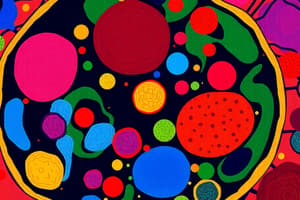Podcast
Questions and Answers
What is the role of the sarcomere in muscle anatomy?
What is the role of the sarcomere in muscle anatomy?
- It is the unit that stores calcium ions for muscle contraction.
- It regulates the blood supply to the muscle tissue.
- It provides structural support to the muscle fibers.
- It is the contractile unit of skeletal muscle. (correct)
Which type of muscle is characterized by voluntary control and striations?
Which type of muscle is characterized by voluntary control and striations?
- Smooth muscle
- Skeletal muscle (correct)
- Cardiac muscle
- Involuntary muscle
What process allows muscles to contract more by utilizing additional muscle fibers?
What process allows muscles to contract more by utilizing additional muscle fibers?
- Summation (correct)
- Treppe
- Tetany
- Fatigue
What characterizes the all-or-nothing response in muscle fibers?
What characterizes the all-or-nothing response in muscle fibers?
Which component of muscle physiology provides energy during fatigue?
Which component of muscle physiology provides energy during fatigue?
What is one of the main functions of the lysosomes in eukaryotic cells?
What is one of the main functions of the lysosomes in eukaryotic cells?
Which of the following statements about prokaryotic cells is true?
Which of the following statements about prokaryotic cells is true?
Which phase of mitosis involves the separation of sister chromatids?
Which phase of mitosis involves the separation of sister chromatids?
What is the main outcome of Meiosis I?
What is the main outcome of Meiosis I?
What characterizes prions among infectious agents?
What characterizes prions among infectious agents?
Flashcards
Large Intestine Function
Large Intestine Function
Absorbs water and salts from undigested food.
Pancreas Function
Pancreas Function
Releases enzymes and hormones, including those that regulate blood sugar.
Kidney Structure
Kidney Structure
Part of the urinary system, it contains a medulla and a cortex, with nephrons being the functional units.
Sarcomere Definition
Sarcomere Definition
Signup and view all the flashcards
Skeletal Muscle Contraction
Skeletal Muscle Contraction
Signup and view all the flashcards
Cell Theory
Cell Theory
Signup and view all the flashcards
Eukaryotic Cell
Eukaryotic Cell
Signup and view all the flashcards
Mitosis
Mitosis
Signup and view all the flashcards
Meiosis
Meiosis
Signup and view all the flashcards
Cell Cycle
Cell Cycle
Signup and view all the flashcards
Study Notes
Cell Theory
- All organisms are made of cells
- Cells are the basic functional unit of life
- Cells come from pre-existing cells
- Cells carry genetic information (DNA)
Eukaryotic Cells
- Nucleus: Double-layered envelope containing DNA; Nucleolus synthesizes rRNA
- Mitochondria: Outer membrane, intermembrane space, inner membrane, matrix; Proton-motive force: pumps H+ from matrix to intermembrane space; Apoptosis via cytochrome C release from ETC
- Lysosomes: Autolysis via release of hydrolytic enzymes from cells
- Endoplasmic Reticulum (ER):
- Rough ER: Studded ribosomes and translates secreted proteins
- Smooth ER: Lipid synthesis, detoxification, and protein transport
- Golgi apparatus: Modifies materials from the ER
- Peroxisomes: H₂O₂ production to break down VLCFAs; assists in phospholipid synthesis and the pentose phosphate pathway
- Cytoskeleton:
- Microfilaments (actin rods): Protection, muscle contraction (with myosin), cleavage furrow
- Microtubules (tubulin tubes): Motor protein pathway (kinesis and dynein), centrioles, cilia (cell movement), and flagella (overall cell movement); 9+2 structure found only in eukaryotes
- Intermediate filaments (keratin, desmin, vimentin, lamins): Cell-cell adhesion, maintains cytoskeleton, cell rigidity, anchors organelles
- Types of Tissues:
- Epithelial: Lines body cavities and forms parenchyma (squamous, cuboidal, columnar, simple, pseudostratified, stratified);
- Connective: Supports body and forms stroma (secretes collagen/elastin to form ECM)
Prokaryotic Cells
- Structure: Cocci (spheres), bacilli (rods), spirilla (spiral); Single circular chromosome in nucleoid; Envelope (cell wall and plasma membrane)
- O₂ Requirements: Obligate aerobes (require oxygen), facultative anaerobes (use oxygen or not), microaerophiles (tolerate low oxygen), aerotolerant anaerobes (tolerate oxygen), obligate anaerobes (die in oxygen)
- Recombination: Transformation (acquire genes from environment), conjugation (transfer genetic material between bacteria), transduction (acquire genes from viruses)
- Growth Stages: Lag phase, Log phase, Stationary phase, Death phase
Viruses
- Virions (nucleocapsids):
- DNA viruses (DNA genome, host machinery): dsDNA (double-stranded DNA), SSDNA (single-stranded DNA)
- RNA viruses (RNA genome, own machinery): dsRNA (double-stranded), ssRNA(+) (single-stranded positive-sense), ssRNA(-) (single-stranded negative-sense)
- Retroviruses: Two copies of ssRNA, reverse transcriptase (RNA to cDNA); Life cycle (bacteriophages only)
Cell Cycle
- Interphase: G₁, S, and G₂ (pre-synthetic gap, DNA synthesis, and post-synthetic gap, respectively) preparing cells for mitosis
- Mitosis (PMAT): Processes that separate duplicated chromosomes and divide cytoplasm into daughter cells (prophase, metaphase, anaphase, and telophase)
- Checkpoints: G₁/S, G₂/M, M/A: Ensure the cell's ready for the process, repair damaged cells, and detect environmental problems
Meiosis
- Reductional division that produces four haploid offspring cells from one diploid parent cell; The process involves two rounds of division. Prophase I (Synapsis, Crossover), Metaphase I, Anaphase I (Disjunction), Telophase I, Meiosis II
Reproductive Processes
- Male Anatomy: SEVE(N) UP (Seminiferous tubules, Epididymis, Vas deferens, Ejaculatory duct, (N) Urethra, Penis); Sertoli and Leydig cells; Spermatogenesis: spermatogonia→1° spermatocyte→2° spermatocyte→spermatid→spermatozoa
- Female Anatomy: Ovaries, Fallopian tubes, Uterus, Vagina, Ovulation, Oogenesis (Oogonia-1° oocyte-2° oocyte and polar body), Fertilization, and Implantation
Early Development
- Fertilization, cleavage, blastulation, implantation (implantation of blastocyst into uterine wall)
Studying That Suits You
Use AI to generate personalized quizzes and flashcards to suit your learning preferences.




